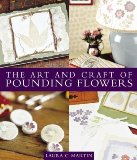I make quilts by pounding flower petals onto muslin. Is there any way to help make the dyes permanent?
Name: Judy
Country or region: USA
Message: I make quilts by pounding flower petals onto pretreated muslin ( alum and baking soda) Is there any way to help make the dyes permanent besides ironing them?
That's a terrifically bad idea for a quilt, unless you never wash your quilts and never sell them. It is suitable only for framing under glass. The colors from pounded flowers are not really dyes; they are only temporary pigments. Neither alum nor baking soda, nor any other household chemical, can be used to make them permanent enough to survive ordinary washing. Ironing won't do it, either, though it helps in preserving flower pigments on material that will never be washed.
There are two options for you to make your flower designs permanent enough to use on a quilt. One is to scan the images into a computer and then print them onto iron-on transfer paper for printing onto a different piece of fabric; the ironed-on designs will last considerably longer than your originals.
The other option is to color over the flower petal spots with fabric paint or fabric markers, covering the ephemeral flower pigments with permanent fabric paint. If you quilt around the outlines of the flower shapes and color them in using permanent fabric paint or marker, then it won't matter so much when the flower pigment fades away, as it inevitably will. You could use a clear colorless fabric paint, Neopaque Colorless Extender, on both the front and the back of your fabric, to seal the flower pigments in; this is better if you happened to chose relatively lightfast plant materials.
If you don't want to use either of these methods, let me urge you to use your designs in making fabric art that will be kept safe from dust and dirt in a picture frame behind glass, because they are not suitable for making quilts that will actually be used.
For more details, see my page, "How can I set the dye from pounding flowers onto cloth?", in the frequently asked questions section of my All About Hand Dyeing web site.
(Please help support this web site. Thank you.)
(Please help support this web site. Thank you.)
Posted: Wednesday - September 12, 2012 at 08:52 AM
Follow this blog on twitter here.
Quick Links
- All About Dyes & Dyeing Top -
- Top of this blog -
- FAQ -
- The Dye Forum -
- How to Tie Dye - How to Batik -
- Books - Toys - Plants -
- Top of this blog -
- FAQ -
- The Dye Forum -
- How to Tie Dye - How to Batik -
- Books - Toys - Plants -
More in this category:
- -
Statistics
Total entries in this blog:
Total entries in this category:
Published On: Sep 12, 2012 09:26 AM
Total entries in this category:
Published On: Sep 12, 2012 09:26 AM
